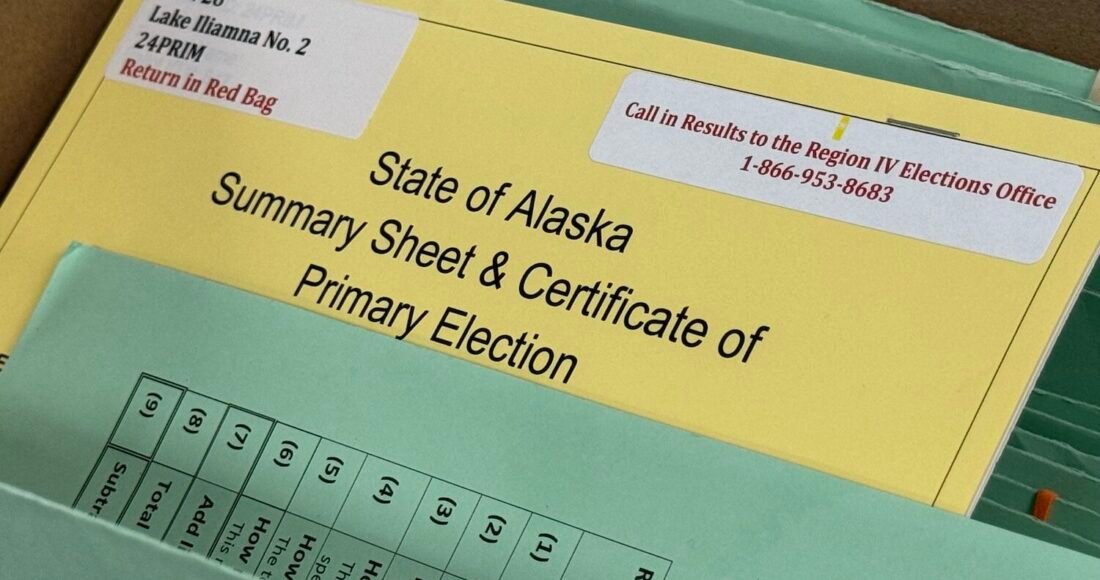Turnout in this year’s state primary election is on pace to be the third lowest in the past 50 years, according to preliminary figures published Tuesday by the Alaska Division of Elections.
Though final certified results aren’t expected until at least Sunday, most ballots have been received and counted.
Through Tuesday evening, 106,208 votes had been counted from just over 17.5% of all registered voters.
This chart, using figures from the Alaska Division of Elections, shows the voter turnout percentage with the line and the number of ballots cast with the bars in each primary election since 1974. The 2024 figure is preliminary. (James Brooks/Alaska Beacon)
Four years ago, Alaskans approved a new elections system that includes an open primary election in which candidates from all parties compete in the same race for each statewide office. The top four vote-getters advance to the general election.
Opponents of the change have succeeded in placing a repeal measure on the November ballot, and some have claimed that the new system is to blame for this year’s low turnout.
A look at the past 50 years’ worth of primary elections points to another potential culprit: a boring ballot.
This year’s primary election is the first since 2000 to have no ballot measures, no governor’s race and no race for U.S. Senate.
In 2000, barely 15% of voters participated in the primary, causing the Anchorage Daily News editorial page to proclaim that turnout was “mighty poor.”
Voters “saw little reason to hit the polls,” the paper reported.
In 2016, Sen. Lisa Murkowski was on the primary ballot, but with no ballot measures and no governor’s race, the result was the second-lowest primary turnout on record.
The state’s burgeoning voter rolls are also a factor in low turnout.
Turnout is the result of simple division — the number of participating voters divided by the number of registered voters.
While the state’s population has plateaued in recent years, the number of registered voters here has risen steadily.
Earlier this year, the Census Bureau estimated that Alaska has 557,899 residents who are at least 18 years old. As of the primary election, the state had 605,482 registered voters, or more than 108% of its voting-age population.
Subtract people who are ineligible to vote — noncitizens and convicted felons in prison, for example — and the state likely has a voter registration rate of more than 110%.
That’s because it’s much easier to register a voter than deregister one.
Alaska has the most transient population in the country, based on the number of people moving into and out of the state each year, and new Alaskans are automatically registered to vote when they get a state driver’s license or apply for the Permanent Fund dividend.
This chart, using data from the Alaska Division of Elections, shows the number of registered voters during each primary election since 1974, noting the start of Permanent Fund dividend automatic voter registration. (James Brooks/Alaska Beacon)
Opting out is possible, but statistics show that relatively few Alaskans take advantage of the opt-out function.
In addition, few Alaskans notify the Division of Elections when they move away, and several states have recently withdrawn from an information-sharing network that notifies elections officials if someone registered in another state.
If a registered voter simply moves away and doesn’t vote in Alaska again, it may take four or more years for that person to be removed from the voter rolls for inactivity.
That combination of factors means the state’s voter rolls are growing, year after year, putting downward pressure on voter turnout rates.
Two years ago, Alaska held a special general election on the same day as the primary election, which gave voters an additional reason to turn out to vote.
In the three statewide primary elections before that one, voter turnout wasn’t significantly different from this year’s election.
Low turnout in August doesn’t mean low turnout in November, however. In 2000, voters turned out in droves after ignoring the polls in November — more than 60% of the state’s registered voters participated in the presidential election that year.
Thus far, there’s no reason to think the pattern will be different this time.






cheap amoxicillin – combamoxi.com cheap amoxicillin pills
order amoxicillin without prescription – https://combamoxi.com/ buy amoxicillin cheap
fluconazole ca – https://gpdifluca.com/# order fluconazole online cheap
order generic fluconazole 200mg – https://gpdifluca.com/ fluconazole 100mg canada
buy cheap escitalopram – https://escitapro.com/ purchase lexapro generic
cenforce 100mg drug – buy cenforce for sale purchase cenforce pill